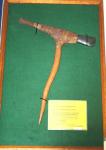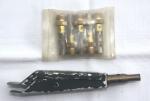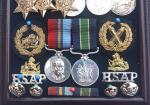-
Posts
13,225 -
Joined
-
Last visited
-
Days Won
22
Content Type
Profiles
Forums
Blogs
Gallery
Events
Store
Everything posted by Mervyn Mitton
-

Zulu items
Mervyn Mitton replied to helen's topic in Great Britain: Militaria: Badges, Uniforms & Equipment
Sitting on an old Zulu meat platter these sets of beads are beautifully made and show a variety of bands and a young maiden's waistbelt - the one at the top. -

Zulu items
Mervyn Mitton replied to helen's topic in Great Britain: Militaria: Badges, Uniforms & Equipment
Northern Kwazulu Natal Zulu ladies still wear these elaborate headresses in old ceremonial dress. Their Zulu name is an Inkehli ( 'h' in Zulu is pronounced 'sh' - so, In-kesh-li). Women started to shape their hair into this shape round about 1900 - however, it was difficult to keep clean and hospitals and clinics used to have it cut off. They then started cutting their own hair and weaving it to this shape - as is still done today. Since it could be damaged when sleeping, the men adapted their stools to become a pillow - you will see many examples above. -

Zulu items
Mervyn Mitton replied to helen's topic in Great Britain: Militaria: Badges, Uniforms & Equipment
I promised to add some new items to Helen's post - actually I have built-up quite a lot, so will spread them over a few threads. January 22nd. marked the 131st. Anniversary of the Battle of Isandlwana. The British Forces were quite soundly beaten on this occasion and this year - mainly because an election is coming soon - and the President of Uganda was visiting - President Zuma and King Goodwill Zwelethini were present. You can ignore the rest - however, the King is wearing ceremonial Leopard skins - lion's teeth and is carrying a ceremonial battle axe and an Iwisa - in this case a small ceremonial knobkerry. This makes it very interesting. -
I think it must be the rarest of the issues. I have never had one in the shop - and to be honest, I don't think I've actually seen one - apart from on uniform photographs.
-
Brett - what an unusual item. Stoneage, but of a modern material. The quality of the 'flaking' to obtain an edge is very finally done and I wouldn't think glass would 'nap' as well as flint - more likely to splinter ? I know many South American tribes use volcanic glass - obsidian - but I think that is a harder material then bottle glass.
-
Brian - I'm so pleased that you have revived this post. The year bars are quite exceptional and I don't think I've seen so many before - he didn't need a truncheon - he could have 'flogged them to death' with the chain.... I was wondering if his rank of Sgt. applied to his Police or St. John's? Was the rank specific to both - or, earned separately ? Never really thought about it before.
-
Hi - Chris. Great to hear from you - you're experiences must have been horrific in the floods and we were all very concerned. When you have time -please write a short account for the Lounge. With the volume of news these days , even the most important events are quickly submerged. (Sorry, that was an unintended pun !) The picture shows an almost identcal picture to the Met. example - probably a standard pattern for many of the old Colonies. The rank badges for a smaller Force show thought had been put-in - is there still a Commissioner for the Queensland Police ? I don't think the Met. wore a cross belt - rather a silver gilt belt with sword suspenders.
-

Transkei, Ciskei, and Bophutwatswana medals
Mervyn Mitton replied to stephenmiller's topic in Africa
Hi Norman. I must congratulate you on putting together such a fine collection of the old Homeland medals. I used to see a lot of them - however, they seem to have disappeared. Perhaps being collected overseas ? One day - like the old enamel shoulder titles - they will become much higher priced. -
Just where does one post a topic on a stoneage axe ? Certainly we don't seem to have a subforum that would cover the subject. Since the New Guinea part was under an Australian Protectorate this seems to be the closest I can find. Actually, it was the people who were /are using stone age implements - like the Australian Aboriginals they come from a very old race and did not have access to metals. The result was that they made all weaponry from wood - with some parts of stone. Some of the inland tribes still persist in this culture - but, as has happened in so many places, progress has brought them into contact with a more modern way of life. During the 1920's many large cruise ships operated out of South Africa and Australia and the Far East were popular destination. You must remember that there was no air transport and not everyone wanted to travel to Europe. I believe that this axe was brought here in that period - and needless to say, was then stored away. It was found a few years ago in a barn outside of Ladysmith in Natal - where the famous siege took place in the Boer War. This was not a tourist piece - it was made to fight with. The stone blade is probably basalt - almost certainly volcanic in origin. The other - smaller head is of wood and you will see that the shaft is pointed for backward strokes at close quarters. Really , quite a formidable weapon. The binding has been expertly done - and was probably then soaked to tighten everything. I think it makes a very decorative display item ?
-

Zulu items
Mervyn Mitton replied to helen's topic in Great Britain: Militaria: Badges, Uniforms & Equipment
My apologies for a double post - Windows 7 seems very quick to reproduce itself. However, I will use the space to mention the type of tobacco that was used. High quality tobacco grows throughout Southern Africa -- Rhodesia (now Zimbabwe) was famous for supplying most of the British needs. Zulus used to dry the tobacco and then mix it - the final quantities being to taste - with Dagga (Indian Hemp or, Cannabis). This also grows naturally and most of Europe's cannabis is from Natal ! -

Zulu items
Mervyn Mitton replied to helen's topic in Great Britain: Militaria: Badges, Uniforms & Equipment
Dear Helen - nice to hear from you - and what a wonderful little piece you have shown. Strangely enough I was thinking it was time we added to this post and I have a few items I will put on next week. This little strigil is quite a common item with Zulus to clean the body of dirt and sweat. They are usually of stone or, bone - but, I have never seen one incorporating a snuff bottle. This will make it a very rare item and for insurance - think of about 700pounds ($1100) The material is probably an antelope horn - lighter colour then a cow's. Shaped from one piece and the swelling end would have a hollow which forms the snuff container. The little pyramid top is made from an offcut. I have often seen this done with hippo teeth and ivory. To be used as a scraper the long section needs a curve - however, this also allows it to be carried stuck into the hair - which is how this would have been carried. An ornament - a mark of status - and, a useful tool all in one...... I should have asked the question - why not use a towel. The Zulus did not have cotton - or, any other type of cloth - which is why they traditionally wear skins. -
Looking at your illustrations I would say that it looks genuine. Obviously, a final opinion always depends on viewing - however, the acid etching for the panel would not be easy to do. You say that you can get it at a reasonable price - sometimes that can be a giveaway - particularly from a dealer. However, if it is a private purchase, I would personally take a chance. At auction I think a 1st pattern could be well in excess of 1000pounds ($1600) . Phone Wallis and Wallis - in Lewes , Sussex - and see what they would say for price. Remember the SAS motto - 'He who hesitates is lost'. Well, something like that, but, quite simply you will not get many opportunities at a 1st. pattern.
-
http://gmic.co.uk/uploads/monthly_01_2011/post-6209-0-40832100-1295954505.jpgThis unusual little item came-in recently with a set of Rhodesian medals (see British Medals). He was a senior officer with the British South African Police and these alarm guns were secured in vulnerable places. A trip wire would be run and if stepped on would fire the blank cartridge. The alternative way to use, would be to fix it under a door - so that it went off if opened - and also, where someone might walk on a path in the bush. The Rhodesian Police probably distributed these to farmers and would have used them to protect their own camps. I expect this one was used to protect the officer's home. The top is left slightly open and pressure closes it - releasing a spring holding the firing pin. Opened-up photos show this. There are 5 unfired blank cartidges in the sealed plastic holder. Alarm guns have been in use for hundreds of years - gamekeepers in Britain used to leave ones firing shot in the woods. They were succesful as long as it wasn't wet or damp - this would affect the flintlock.
-
This shows the reverse of the two medals. The GSM has the Rhodesian Arms - whilst the LS&GC has retained the truncheon from the British overseas police awards. However, the wording and the shape of the truncheon make it unique to Rhodesia - and therefore , it is a rare medal to an Officer of what was a small force. The Medal Yearbook has not been listing Rhodesian medals - unless they added this year ? I know that to many members the collecting of Rhodesian material is difficult - small amounts only are available and so much was dumped in the Zambezi river when people were leaving - they were worried that mementoes would get them into trouble. However, my advice - buy what you can - prices can only increase. Be careful of re-names - particularly for the early 1890's medals. I understand that some of the dies were stolen from the Museum in 1980 and care should be taken - this is particularly so with the 1896. I usually only buy this one if it is in a group. Leigh - I hope I was able to answer your question ? Mervyn
-
The medal on the left is the Rhodesian GSM - named to 5850 S/O R.A.Vincent. The right hand is the LS&GC for 18 years service. The badge on the left is for male officers' in the BSAP - the one on the right is gilt bullion - for Commissioner rank. Look carefully at the crossed tipstaffs. I mentioned in an earlier post that the Rhodesians wanted to keep links with Britain and this is a perfect example - however, the Crowns which should surmount the staffs have been taken out. Under these cap badges are the gilt collars for Officers' in the UDI period. Then standard shoulder titles for B S A P and finally, some gilt buttons - again UDI.
-
I have had quite few Rhodesian medals through recently - however, this one stands out as it is a family pair for Father and Son. With regard to Rhodesian items you must now remember that it is 31 years since the short lived period of U.D.I. - 1965 - 1980. There is demand Worldwide , partly to be accounted for by the small and diverse units in the Rhodesian Forces - but, mainly because as a Country with the full array of Government Institutuons - they ceased to exist on 'handover'. Regard any that you have as investments and collect whenever possible. The Father was - 63250 W.N.VINCENT - he was in the South African armoured units and was badly wounded in Italy when his tank was destroyed. I understand that he took a year to recover. The family know little about his war service and until I can draw papers any info. will be appreciated. The lower set is of importance. 5850 R.A.VINCENT - was, in the 1950's, with the British South Africa Police Reserve. From what I have been able to establish from badges that came with the medals, he was a sergeant with the Reserves, later a senior sergeant and then a station officer. He must have joined as a regular around the time of UDI and would have been commissioned due to his previous service. His LS & GC is named to 5850 Chief Inspector R.A.Vincent - but I am not sure of the date for this. It marks 18 years service - and subsequent bars marked each 5 years - perhaps it all ended before he could claim them ? He went on to be a Superintendent - a Chief Superintendent , which I think was his substantative rank - and an Asst. Commissioner. In this rank he would have been responsible for a large district. There was an additional rank of senior Asst.Comm. - who would have had duties similar to the Metropolitan Police in London. The medals, as I said, came with all of his gilt badges and so a good board has been possible. I will post additional badges separately. I knew Bob Vincent personally - he lived here after leaving Rhodesia and ran the main builder's supply shop. He told me many of his police stories since we shared a background - but, he was modest and I never knew he made Asst.Comm. rank . I am hoping to be able to add his cased sword.













